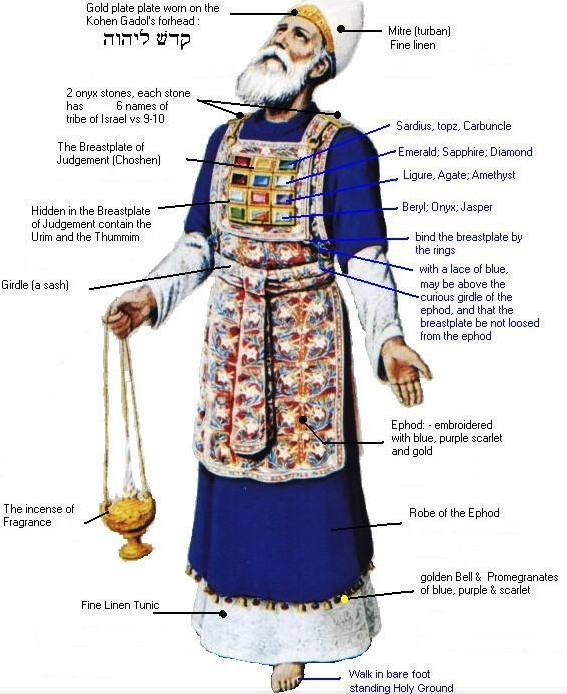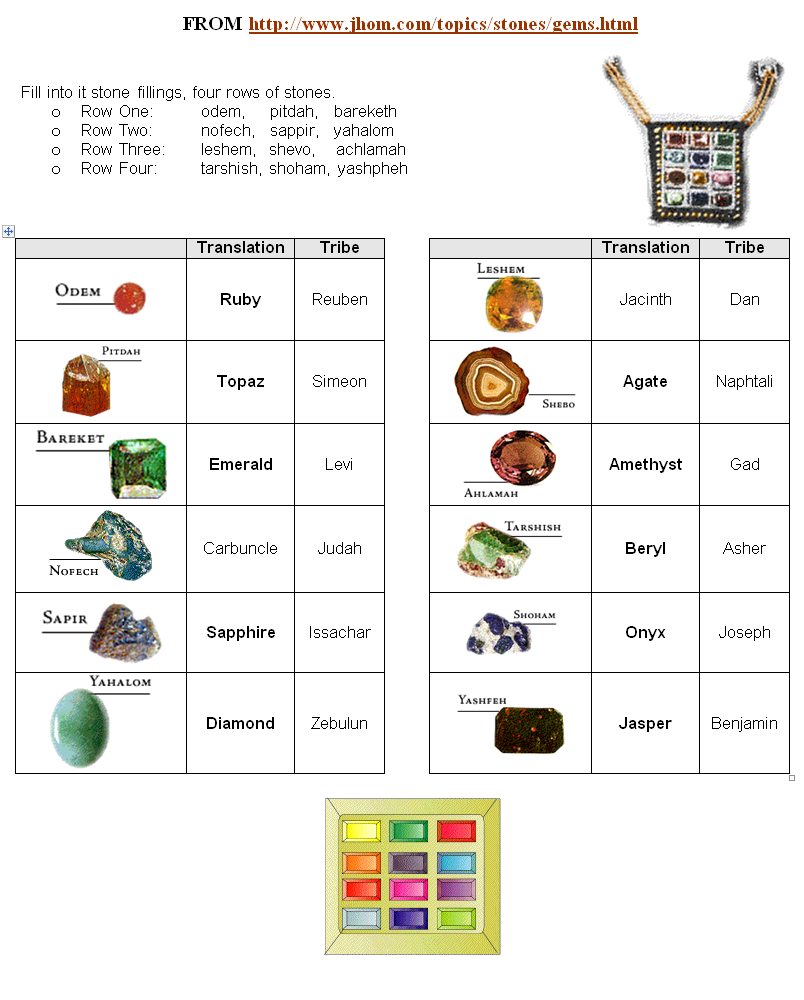G-d tells Moses how to make garments for Aaron and his sons who will serve as kohanim
- Aaron, and his sons will serve [as kohanim]: Aaron, Nadab, and Abihu, Eleazar, and Ithamar
- Make holy garments for your brother Aaron, for honor and glory. Wise hearted, whom I have filled with the spirit of wisdom, will make Aaron's garments to sanctify him, so that he can serve Me
- Make these garments:
- choshen
- ephod
- robe
- tunic of checker work
- cap
- sash
Ephod
- Make the ephod of gold, blue, purple, and crimson wool, and twisted fine linen, the work of a master weaver.
- It shall have two connected shoulder straps at both its ends, and it shall be entirely connected.
- Its decorative band, which is above it, shall be of the same work, [emanating] from it: gold, blue, purple, and crimson wool, and twisted fine linen.
- Take two shoham stones and engrave upon them the names of the sons of Israel. Six of their names on one stone and the names of the remaining six on the second stone, according to their births.
- [Similar to] the work of an engraver of gems, [similar to] the engravings of a seal, you shall engrave the two stones with the names of the sons of Israel; you shall make them enclosed in gold settings.
- Put the two stones upon the shoulder straps of the ephod as stones of remembrance for the sons of Israel, and Aaron shall carry their names before the Lord upon his two shoulders as a remembrance.
- Make settings of gold, and two chains of pure gold you will make them attached to the edges, after the manner of cables, and you will place the cable chains upon the settings.
Choshen
- Make a choshen of judgment, the work of a master weaver. You shall make it like the work of the ephod; of gold, blue, purple, and crimson wool, and twisted fine linen shall you make it.
- It shall be square [and] doubled; its length one span and its width one span.
- Fill into it stone fillings, four rows of stones.
- Row One: odem, pitdah, bareketh
- Row Two: nofech, sappir, yahalom
- Row Three: leshem, shevo, achlamah
- Row Four: tarshish, shoham, yashpheh
- They shall be set in gold in their fillings.
- The stones shall be for the names of the sons of Israel twelve, corresponding to their names; [similar to] the engravings of a seal, every one according to his name shall they be, for the twelve tribes.
- Make for the choshen chains at the edges, of cable work, of pure gold.
- Make for the choshen two golden rings, and place the two rings on the two ends of the choshen,
- Place the two golden cables on the two rings, at the ends of the choshen.
Connecting Choshen to Ephod
- The two ends of the two cables place upon the two settings, and [these] place upon the shoulder straps of the ephod, on its front part.
- Make two golden rings, and place them on the two ends of the choshen, on its edge that is toward the inner side of the ephod.
- Make two golden rings and place them on the two shoulder straps of the ephod, from below, toward its front, adjacent to its seam, above the band of the ephod.
- Fasten the choshen by its rings to the rings of the ephod with a blue cord, so that it may be upon the band of the ephod, and the choshen will not move off the ephod.
- Thus shall Aaron carry the names of the sons of Israel in the choshen of judgment over his heart when he enters the Holy, as a remembrance before the Lord at all times.
- Place the Urim and the Tummim into the choshen of judgment so that they will be over Aaron's heart when he comes before the Lord, and Aaron will carry the judgment of the children of Israel over his heart before the Lord at all times.
Robe
- Make the robe of the ephod completely of blue wool.
- Its opening at the top shall be turned inward; its opening shall have a border around it, the work of a weaver. It shall have [an opening] like the opening of a coat of armor; it shall not be torn.
- On its bottom hem make pomegranates of blue, purple, and crimson wool, on its bottom hem all around, and golden bells in their midst all around.
- A golden bell and a pomegranate, a golden bell and a pomegranate, on the bottom hem of the robe, all around.
- It shall be on Aaron when he performs the service, and its sound shall be heard when he enters the Holy before the Lord and when he leaves, so that he will not die
Cap Showplate
- Make a showplate of pure gold, and engrave upon it like the engraving of a seal: Holy to the Lord."
- Place it upon a cord of blue wool and it shall go over the cap, and it shall be opposite the front side of the cap.
- It shall be upon Aaron's forehead, and Aaron shall bear the iniquity of the holy things that the children of Israel sanctify, for all their holy gifts. It shall be upon his forehead constantly to make them favorable before the Lord.
Tunic, Cap, Sash, Pants
- Make the linen tunic of checker work, and you shall make a linen cap; and you shall make a sash of embroidery work.
- For Aaron's sons make tunics and make them sashes, and make them high hats for honor and glory.
- With these you shall clothe Aaron, your brother, and his sons along with him, and you shall anoint them and invest them with full authority and sanctify them so that they may serve Me [as kohanim].
- Make for them linen pants to cover the flesh of [their] nakedness; they shall reach from the waist down to the thighs.
- They shall be worn by Aaron and by his sons when they enter the Tent of Meeting or when they approach the altar to serve in the Holy, so they will not bear iniquity and die. It shall be a perpetual statute for him and for his descendants after him.
- to sanctify him, [so] that he serve Me [as a kohen] Heb. לְקַדְּשׁוֹ לְכַהִנוֹ-לִי, to sanctify him, to initiate him into the kehunah through these garment [so] that he would be a kohen to Me. The expression of kehunah means service, serjanterie [or serventrie] in Old French.
- a choshen An ornament opposite the heart.
- a cap Heb. מִצְנֶפֶת, a type of dome-shaped hat, called cofia in Old French, because elsewhere (verse 40) [the Torah] calls them מִגְבָּעוֹת, and the Targum [Onkelos] renders: כּוֹבָעִין.
- a sash This is the belt on the tunic, and the ephod is the belt on the robe, as we find in the order they were put on: “and put upon him the tunic, girded him with the sash, clothed him with the robe, put upon him the ephod” (Lev. 8:7).
- and they shall make the ephod If I would try to explain the making of the ephod and the choshen according to the order of the verses, their explanation would be fragmentary and the reader would err in combining them. Therefore, I am writing [first] how they were made, as it was [i.e., in its entirety], so that the reader will be able to run through it [quickly]. Afterwards, I will explain it [how they were made] according to the sequence of the verses. The ephod was designed like a sort of apron worn by women who ride horseback [see Rashi on verse 4], and he [the Kohen Gadol] would gird [himself with] it from behind, opposite his heart, below his elbows, its width equaling the width of a man’s back and more, and it [the ephod] would reach his ankles. The belt was attached to the top of it across its width, [it was] the work of a weaver, and it extended on both sides in order to wrap [the Kohen Gadol] and gird [him] with it. The shoulder straps were attached to the belt-one to the right and one to the left from behind the Kohen [Gadol], at the two ends of the width of the apron. When he held them [i.e., the shoulder straps] upright, they stood [i.e., lay flat] on his two shoulders. They were like two straps made from the same material as the ephod [and they were] long enough to place them upright alongside his neck on either side. They were folded in front of him slightly below his shoulders. The shoham stones were set in them-one on the right shoulder strap and one on the left shoulder strap. The settings were placed at their ends in front of his shoulders, and the two golden chains were inserted into the two rings of the choshen at the two ends of its upper width-one on the right and one on the left. The two ends of the [right] chains were inserted into the settings on the right, and similarly the two ends of the left chains were inserted into the settings on the left shoulder strap. Thus, the choshen was suspended on the settings of the ephod in front of him [the Kohen Gadol] over his heart. There were two more rings on the two ends of the choshen, on the bottom of it. Opposite them [there were] two rings on the two shoulder straps from below, at its bottom end, which was attached to the belt. The rings of the choshen [were] opposite the rings of the ephod, lying on each other. He would fasten them [the rings] with a blue cord, inserted through the rings of the ephod and the choshen, attached to the band of the ephod, so that the bottom of the choshen would be attached to the band of the ephod, and it would not swing back and forth.
- the Urim and the Tummim This [refers to the] inscription of the explicit Name, which he [Moshe] would place within the folds of the choshen, through which it would light up its words (מֵאִיר) and perfect (מְךְתַּמֵם) its words. [I.e., the Urim and Tummim explain their words, and their predictions never fail (on Yoma 73b).] In the Second Temple there was the choshen, because it was impossible for the Kohen Gadol to be missing [any of the original] garments, but that Name was not inside it. Because of that Name, it was called “judgment,” as it is said: “and he shall inquire for him through the judgment of the Urim” (Num. 27:21).
- linen pants Thus [we have] eight garments for the Kohen Gadol and four for the ordinary kohen.










